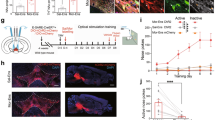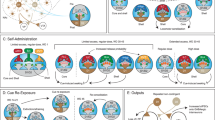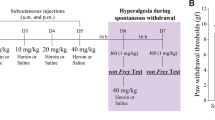Abstract
Glutamatergic neurons in ventral pallidum (VPGlu) were recently reported to mediate motivational and emotional behavior, but its role in opioid addiction still remains to be elucidated. In this study we investigated the function of VPGlu in the context-dependent heroin taking and seeking behavior in male rats under the ABA renewal paradigm. By use of cell-type-specific fiber photometry, we showed that the calcium activity of VPGlu were inhibited during heroin self-administration and context-induced relapse, but activated after extinction in a new context. The drug seeking behavior was accompanied by the decreased calcium signal of VPGlu. Chemogenetic manipulation of VPGlu bidirectionally regulated heroin taking and seeking behavior. Anterograde tracing showed that the lateral habenula, one of the epithalamic structures, was the major output region of VPGlu, and its neuronal activity was consistent with VPGlu in different phases of heroin addiction and contributed to the motivation for heroin. VPGlu axon terminals in LHb exhibited dynamic activity in different phases of heroin addiction. Activation of VPGlu-LHb circuit reduced heroin seeking behavior during context-induced relapse. Furthermore, the balance of excitation/inhibition from VP to LHb was shifted to enhanced glutamate transmission after extinction of heroin seeking motivation. Overall, the present study demonstrated that the activity of VPGlu was involved in the regulation of heroin addiction and identified the VPGlu-LHb pathway as a potential intervention to reduce heroin seeking motivation.
This is a preview of subscription content, access via your institution
Access options
Subscribe to this journal
Receive 12 print issues and online access
$259.00 per year
only $21.58 per issue
Buy this article
- Purchase on Springer Link
- Instant access to full article PDF
Prices may be subject to local taxes which are calculated during checkout








Similar content being viewed by others
References
Crombag HS, Bossert JM, Koya E, Shaham Y. Review. Context-induced relapse to drug seeking: a review. Philos Trans R Soc Lond B Biol Sci. 2008;363:3233–43.
Cooper S, Robison AJ, Mazei-Robison MS. Reward circuitry in addiction. Neurotherapeutics. 2017;14:687–97.
Kupchik YM, Prasad AA. Ventral pallidum cellular and pathway specificity in drug seeking. Neurosci Biobehav Rev. 2021;131:373–86.
Richard JM, Ambroggi F, Janak PH, Fields HL. Ventral pallidum neurons encode incentive value and promote cue-elicited instrumental actions. Neuron. 2016;90:1165–73.
Smith KS, Berridge KC. The ventral pallidum and hedonic reward: neurochemical maps of sucrose “liking” and food intake. J Neurosci. 2005;25:8637–49.
Ottenheimer D, Richard JM, Janak PH. Ventral pallidum encodes relative reward value earlier and more robustly than nucleus accumbens. Nat Commun. 2018;9:4350.
Prasad AA, McNally GP. Ventral pallidum output pathways in context-induced reinstatement of alcohol seeking. J Neurosci. 2016;36:11716–26.
Prasad AA, Xie C, Chaichim C, Nguyen JH, McClusky HE, Killcross S, et al. Complementary roles for ventral pallidum cell types and their projections in relapse. J Neurosci. 2020;40:880–93.
Pribiag H, Shin S, Wang EH, Sun F, Datta P, Okamoto A, et al. Ventral pallidum DRD3 potentiates a pallido-habenular circuit driving accumbal dopamine release and cocaine seeking. Neuron. 2021;109:2165–82.e10.
Badiani A, Belin D, Epstein D, Calu D, Shaham Y. Opiate versus psychostimulant addiction: the differences do matter. Nat Rev Neurosci. 2011;12:685–700.
Ettenberg A, Pettit HO, Bloom FE, Koob GF. Heroin and cocaine intravenous self-administration in rats: mediation by separate neural systems. Psychopharmacol (Berl). 1982;78:204–9.
Galaj E, Han X, Shen H, Jordan CJ, He Y, Humburg B, et al. Dissecting the role of GABA neurons in the VTA versus SNr in opioid reward. J Neurosci. 2020;40:8853–69.
Hubner CB, Koob GF. The ventral pallidum plays a role in mediating cocaine and heroin self-administration in the rat. Brain Res. 1990;508:20–9.
Rogers JL, Ghee S, See RE. The neural circuitry underlying reinstatement of heroin-seeking behavior in an animal model of relapse. Neuroscience. 2008;151:579–88.
Hur EE, Zaborszky L. Vglut2 afferents to the medial prefrontal and primary somatosensory cortices: a combined retrograde tracing in situ hybridization study [corrected]. J Comp Neurol. 2005;483:351–73.
Faget L, Zell V, Souter E, McPherson A, Ressler R, Gutierrez-Reed N, et al. Opponent control of behavioral reinforcement by inhibitory and excitatory projections from the ventral pallidum. Nat Commun. 2018;9:849.
Liu B, Cao Y, Wang J, Dong J. Excitatory transmission from ventral pallidum to lateral habenula mediates depression. World J Biol Psychiatry. 2020;21:627–33.
Stephenson-Jones M, Bravo-Rivera C, Ahrens S, Furlan A, Xiao X, Fernandes-Henriques C, et al. Opposing contributions of GABAergic and Glutamatergic ventral pallidal neurons to motivational behaviors. Neuron. 2020;105:921–933.e5.
Wang F, Zhang J, Yuan Y, Chen M, Gao Z, Zhan S, et al. Salience processing by glutamatergic neurons in the ventral pallidum. Sci Bull (Beijing). 2020;65:389–401.
Levi LA, Inbar K, Nachshon N, Bernat N, Gatterer A, Inbar D, et al. Projection-specific potentiation of ventral pallidal glutamatergic outputs after abstinence from cocaine. J Neurosci. 2020;40:1276–85.
Bossert JM, Liu SY, Lu L, Shaham Y. A role of ventral tegmental area glutamate in contextual cue-induced relapse to heroin seeking. J Neurosci. 2004;24:10726–30.
Crombag HS, Shaham Y. Renewal of drug seeking by contextual cues after prolonged extinction in rats. Behav Neurosci. 2002;116:169–73.
Cui Y, Yang Y, Ni Z, Dong Y, Cai G, Foncelle A, et al. Astroglial Kir4.1 in the lateral habenula drives neuronal bursts in depression. Nature. 2018;554:323–7.
Proulx CD, Aronson S, Milivojevic D, Molina C, Loi A, Monk B, et al. A neural pathway controlling motivation to exert effort. Proc Natl Acad Sci USA. 2018;115:5792–7.
Meye FJ, Soiza-Reilly M, Smit T, Diana MA, Schwarz MK, Mameli M. Shifted pallidal co-release of GABA and glutamate in habenula drives cocaine withdrawal and relapse. Nat Neurosci. 2016;19:1019–24.
Valentinova K, Tchenio A, Trusel M, Clerke JA, Lalive AL, Tzanoulinou S, et al. Morphine withdrawal recruits lateral habenula cytokine signaling to reduce synaptic excitation and sociability. Nat Neurosci. 2019;22:1053–6.
Aizawa H, Kobayashi M, Tanaka S, Fukai T, Okamoto H. Molecular characterization of the subnuclei in rat habenula. J Comp Neurol. 2012;520:4051–66.
Fattorini G, Verderio C, Melone M, Giovedì S, Benfenati F, Matteoli M, et al. VGLUT1 and VGAT are sorted to the same population of synaptic vesicles in subsets of cortical axon terminals. J Neurochem. 2009;110:1538–46.
Heinsbroek JA, Bobadilla AC, Dereschewitz E, Assali A, Chalhoub RM, Cowan CW, et al. Opposing regulation of cocaine seeking by glutamate and GABA neurons in the ventral pallidum. Cell Rep. 2020;30:2018–2027.e3.
Vitcheva V. Cocaine toxicity and hepatic oxidative stress. Curr Med Chem. 2012;19:5677–82.
Johnson SW, North RA. Opioids excite dopamine neurons by hyperpolarization of local interneurons. J Neurosci. 1992;12:483–8.
Freeman KB, Konaklieva MI, Riley AL. Assessment of the contributions of Na+ channel inhibition and general peripheral action in cocaine-induced conditioned taste aversion. Pharmacol Biochem Behav. 2005;80:281–8.
Rogerio R, Takahashi RN. Anxiogenic properties of cocaine in the rat evaluated with the elevated plus-maze. Pharmacol Biochem Behav. 1992;43:631–3.
Jhou TC, Good CH, Rowley CS, Xu SP, Wang H, Burnham NW, et al. Cocaine drives aversive conditioning via delayed activation of dopamine-responsive habenular and midbrain pathways. J Neurosci. 2013;33:7501–12.
Zuo W, Chen L, Wang L, Ye JH. Cocaine facilitates glutamatergic transmission and activates lateral habenular neurons. Neuropharmacology. 2013;70:180–9.
Li H, Eid M, Pullmann D, Chao YS, Thomas AA, Jhou TC. Entopeduncular nucleus projections to the lateral habenula contribute to cocaine avoidance. J Neurosci. 2021;41:298–306.
Lammel S, Lim BK, Ran C, Huang KW, Betley MJ, Tye KM, et al. Input-specific control of reward and aversion in the ventral tegmental area. Nature. 2012;491:212–7.
Matsumoto M, Hikosaka O. Lateral habenula as a source of negative reward signals in dopamine neurons. Nature. 2007;447:1111–5.
Mathis VP, Williams M, Fillinger C, Kenny PJ. Networks of habenula-projecting cortical neurons regulate cocaine seeking. Sci Adv. 2021;7:eabj2225.
Nair SG, Smirnov DS, Estabrook MM, Chisholm AD, Silva PR, Neumaier JF. Effect of chemogenetic inhibition of lateral habenula neuronal activity on cocaine- and food-seeking behaviors in the rat. Addict Biol. 2021;26:e12865.
Wulff AB, Tooley J, Marconi LJ, Creed MC. Ventral pallidal modulation of aversion processing. Brain Res. 2019;1713:62–9.
Acknowledgements
This research was supported by the Major Project of the Science and Technology Innovation 2030 of China (2021ZD0203500, STI2030-Major Projects 2021ZD0202900); National Natural Science Foundation of China (82030112, 81773710, 82371533, 82301677); Science and Technology Commission of Shanghai Municipality (20ZR1468200); Natural Science Foundation of Shanghai (22ZR1449300); Program of Shanghai Academic/Technology Research Leader (22XD1402400) and Shenzhen-Hong Kong Institute of Brain Science—Shenzhen Fundamental Research Institutions (NYKFKT2019015).
Author information
Authors and Affiliations
Contributions
ZQL, RSC and JL conceived this study and design the experiment; RSC and JL conducted the experiments with the assistance of YJW and KN; RSC and JL analyzed the data and wrote the manuscript; ZQL and JGL revised the manuscript.
Corresponding authors
Ethics declarations
Competing interests
The authors declare no competing interests.
Supplementary information
Rights and permissions
Springer Nature or its licensor (e.g. a society or other partner) holds exclusive rights to this article under a publishing agreement with the author(s) or other rightsholder(s); author self-archiving of the accepted manuscript version of this article is solely governed by the terms of such publishing agreement and applicable law.
About this article
Cite this article
Chen, Rs., Liu, J., Wang, Yj. et al. Glutamatergic neurons in ventral pallidum modulate heroin addiction via epithalamic innervation in rats. Acta Pharmacol Sin 45, 945–958 (2024). https://doi.org/10.1038/s41401-024-01229-4
Received:
Accepted:
Published:
Issue Date:
DOI: https://doi.org/10.1038/s41401-024-01229-4



